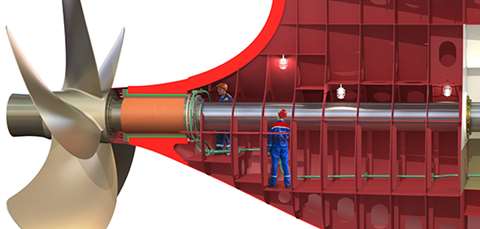Thordon Bearings touts sterntube-less design
08 June 2022
Allows for a shorter, water-lubricated propeller shaft
A design concept for a sterntube-less ship has won Approval in Principle from classification society ABS.
The concept, developed by Thordon Bearings in cooperation with the Shanghai Merchant Ship Design & Research Institute (SDARI), the National Technical University of Athens (NTUA). The rdesign replaces a vessel’s sterntube with an irregular shaped chamber that allows a shorter, water-lubricated propeller shaft to be inspected and maintained while the vessel is afloat, without having to withdraw the shaft in drydock, according to Thordon Bearings.
While the concept completely eliminates the need for oil-lubricated sterntube seals and bearings – a major source of marine pollution – the design is likely to save shipowners hundreds of thousands of dollars in capital and operational expenditure over a vessel’s lifespan, the company said.
 A sterntube-less ship features a shorter shaft with the prime mover further aft the vessel. (Image: Thordon Bearings)
A sterntube-less ship features a shorter shaft with the prime mover further aft the vessel. (Image: Thordon Bearings)
Speaking ahead of an ABS-organized seminar in Athens during the Posidonia trade fair, Anthony Hamilton, Technical Director, Thordon Bearings, said the concept “revolutionizes the ships’ traditional sealed propeller shaft.”
“We started wondering why a vessel with a water-lubricated shaftline needs a sterntube. Why couldn’t the shaft simply run in the larger space outside the sterntube? This space is designed into virtually all vessels where an oil-lubricated sterntube is traditionally exposed to seawater for cooling. With a water-lubricated shaft this space still exists but it’s wasted space.”
Hamilton said the space could be used to access the shaft for inspections, and a lot of the shaft installation and operational challenges “completely disappear.”
A sterntube-less ship features a shorter shaft with the prime mover further aft the vessel. An additional bulkhead seal and a torsional vibration damper would be required but there is no aft seal and Thordon’s COMPAC seawater lubricated bearing replaces the oil-lubricated bearing aft.
“ABS and the Technical University of Athens have done the math and the engineering behind it. They’ve looked at system pressures, temperatures, loads, noise and vibration levels, shaft alignment – everything works,” said Hamilton.
Craig Carter, Thordon Bearings’ VP Business Development, said the design offers cost savings; for one thing, operators would never have to withdraw the shaft again, which can cost US$100,000 plus in drydocking costs alone.
“We are not changing the design of the ship or the stern but by moving the engine further aft we free up more space for cargo,” Carter said.
Dr. Chris Leontopoulos, Director Global Ship Systems Center, ABS Athens, said the use of seawater to lubricate the propeller shaft is well-established but the proposed design takes this further by removing the sterntube, decreasing the shaft line length, reducing engine room space and increasing the cargo space.
STAY CONNECTED




Receive the information you need when you need it through our world-leading magazines, newsletters and daily briefings.
POWER SOURCING GUIDE
The trusted reference and buyer’s guide for 83 years
The original “desktop search engine,” guiding nearly 10,000 users in more than 90 countries it is the primary reference for specifications and details on all the components that go into engine systems.
Visit Now
CONNECT WITH THE TEAM










